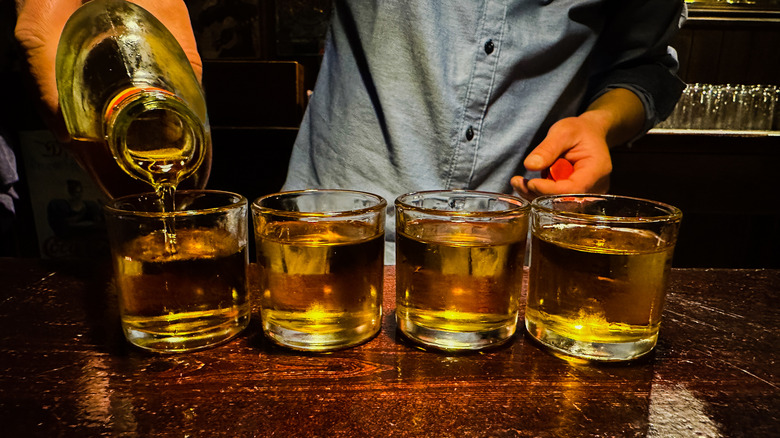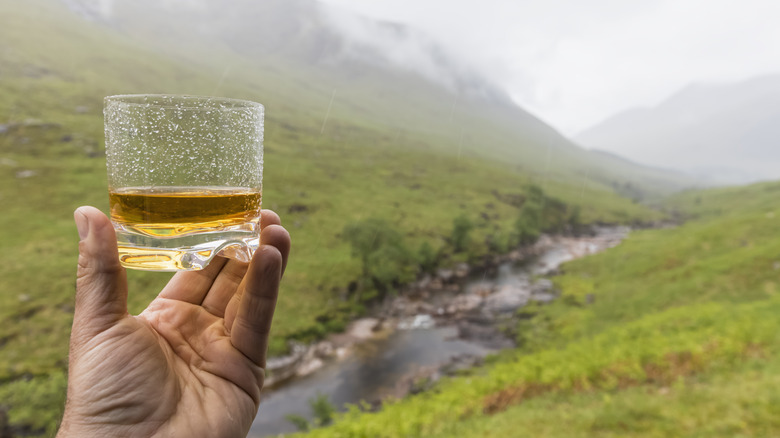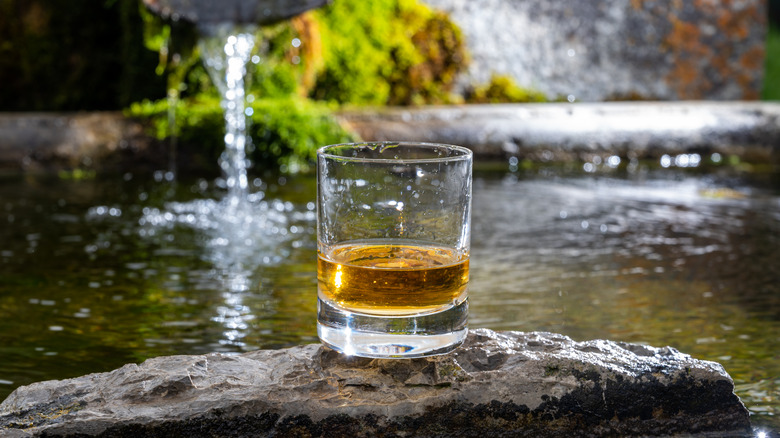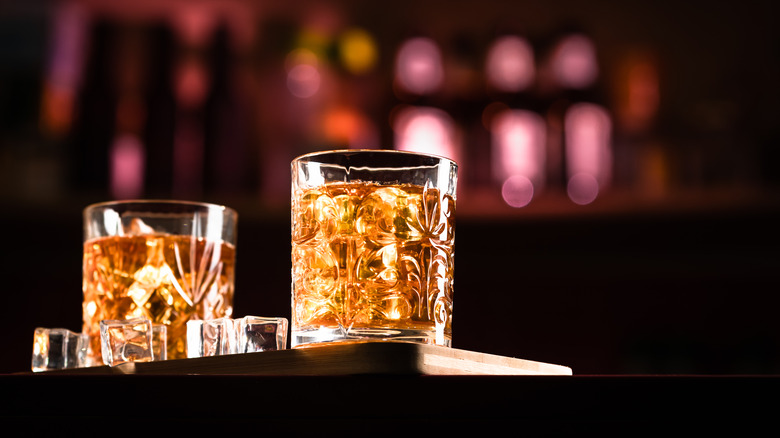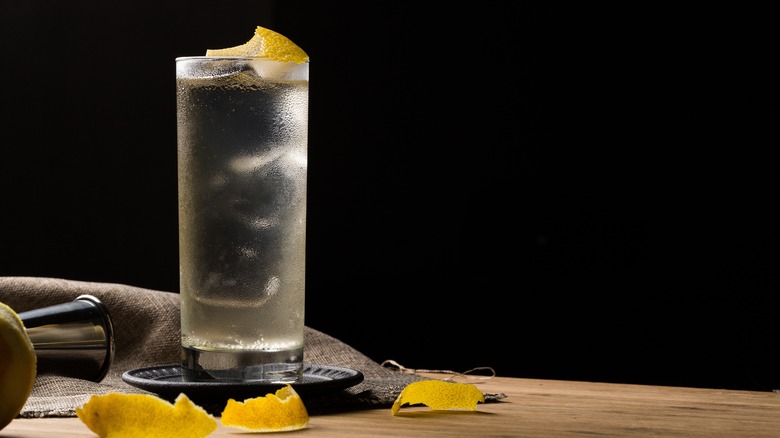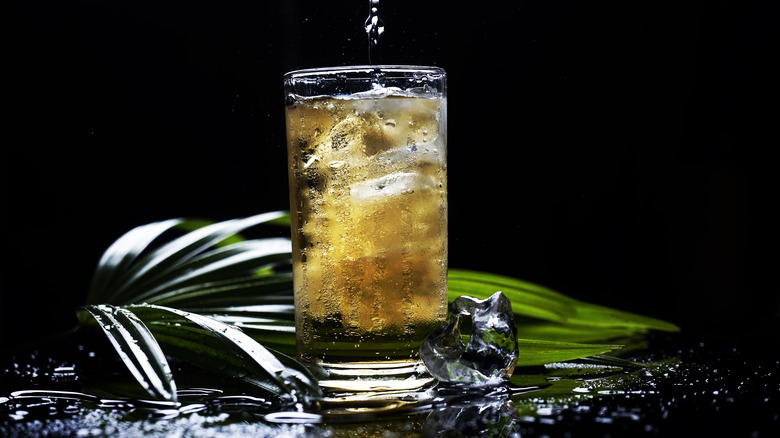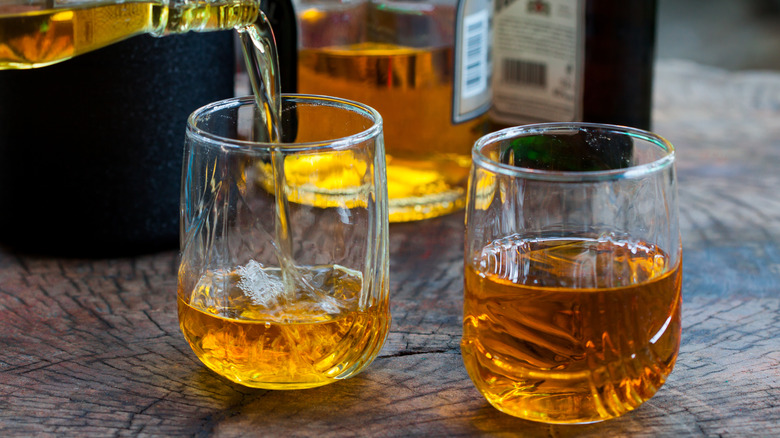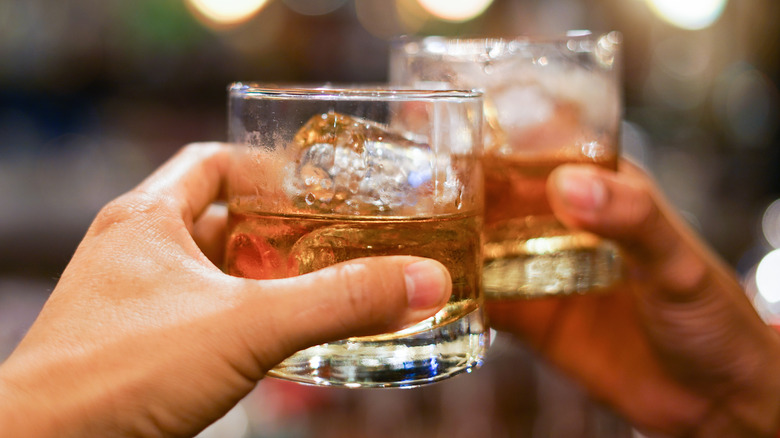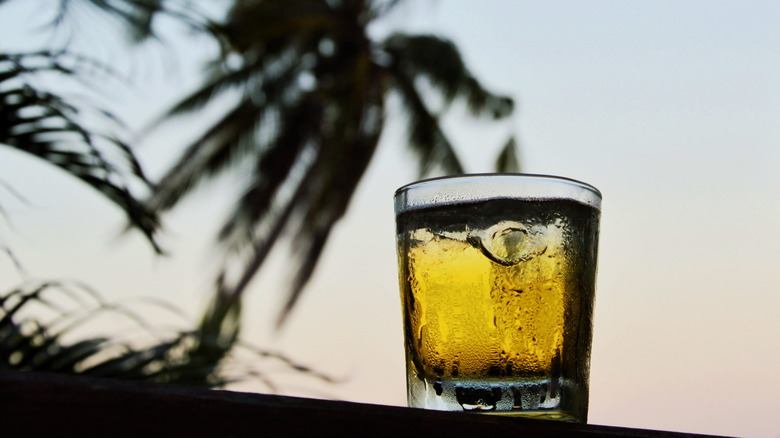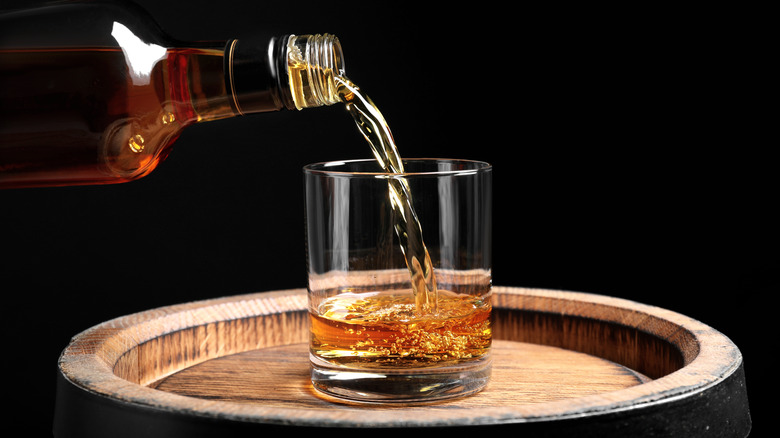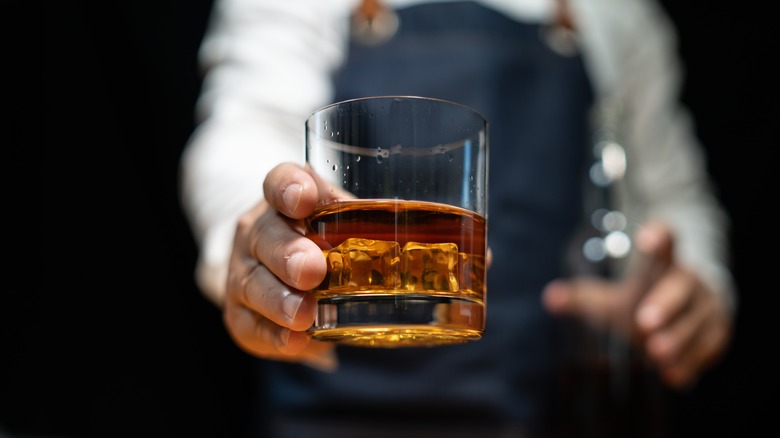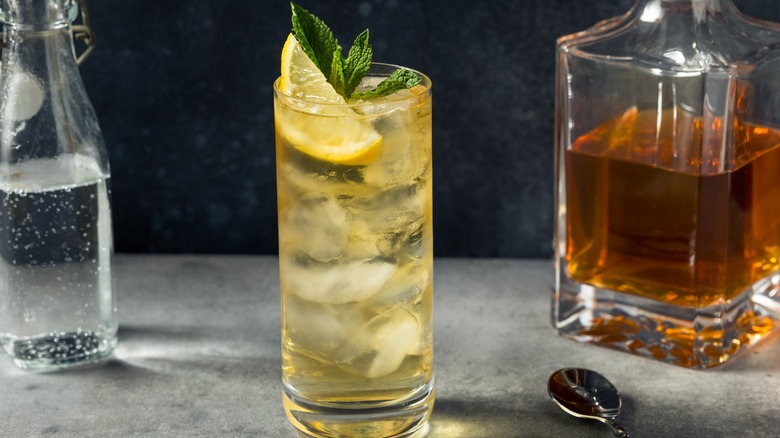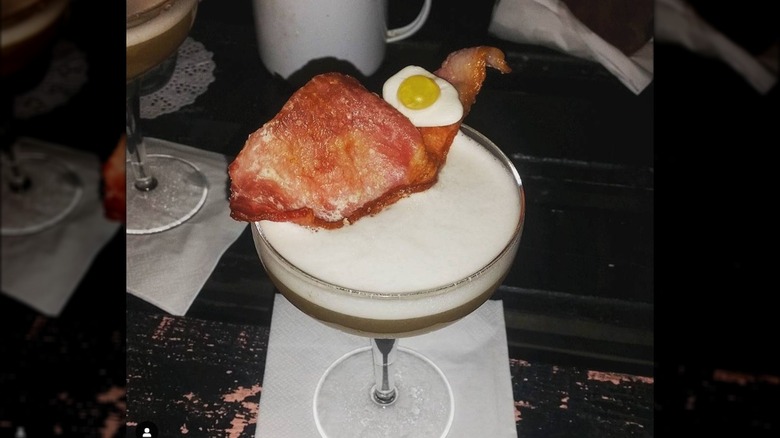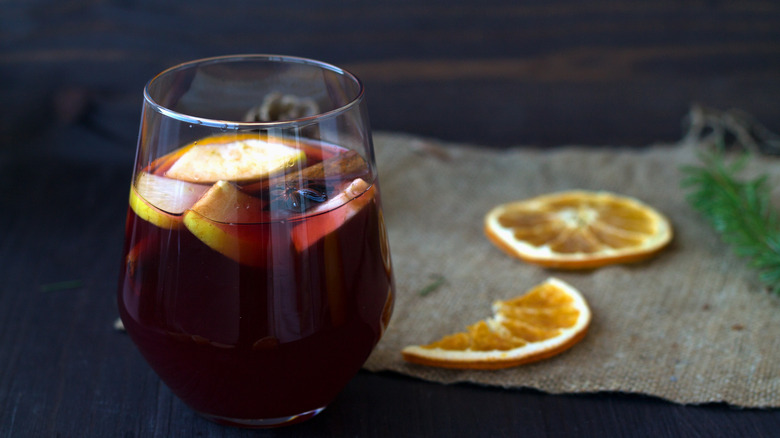13 Ways People Drink Whiskey Around The World
The origin of whiskey has been attributed to Scotland, Ireland, and regions of Europe, muddying the waters regarding which country can lay claim to such a beloved invention. One fact can't be disputed: Whiskey's popularity reaches around the globe, inviting beverage fans worldwide to incorporate the smoky, aged elixir into their drinking habits. Regardless of who takes the title of whiskey's true home, the spirit has found a place on tables and bar tops just about anywhere liquor can be enjoyed.
But not every culture takes its whiskey (or whisky if the spirit is distilled outside the U.S. and Ireland) in the same manner. With so many approaches to pouring this distilled darling of the drinking world, there are local spins that offer unique ways for drinking whiskey. Some involve adding mixers that might intrigue long-time whiskey sippers enough to give it a shot themselves, while others require a more adventurous spirit to bring the glass to your lips. We've tracked down our favorite twists on the whiskey business consumed by drinkers worldwide to see what's shaking with this classic pour and its myriad presentations.
1. In Scotland, they drink it neat
As one of the drink's proclaimed homelands, Scotland has a distinctive association with whiskey and the mystique that surrounds it. Whether you're a native Scot, an expat transplant, or simply visiting the Highland, drinking whiskey in proper Scottish style means taking it neat, with no ice added to the glass to put the freeze on the flavors. This also means drinking it straight, with no mixers to alter the liquid. If a beverage as complex and nuanced as whiskey is best served as-is, then Scotland aims to keep the tradition pure by enjoying the spirit at room temperature only — no ice to chill the contents of the glass or dilute the drinking experience.
Drinking whiskey neat allows both connoisseurs and noobs to appreciate the flavors in their most natural state. Though a few drops of water may be allowable to open up the elements to their fuller potential, the notion of serving whiskey on the rocks is a taboo that could make your fellow drinkers in Scotland look at you sideways across the bar when hearing your order. They may also slide over and school you in a more Scottish way to sip this solution. When a life lesson of such magnitude comes to your table, consider it a gift, accept it with a gracious "thank you," and give the teacher your undivided attention. Scotland Whiskey School is in session.
2. In Ireland, they drink it with added water
You can hardly think of the word "whiskey" without conjuring images of Irish pubs, bottles of Jameson and the much-adored Irish coffee cocktail that incorporates the high-proof chest-warmer as a stir-in to bold bean brew. But it may pass under the radar of even knowledgeable beverage lovers that authentic Irish whiskey drinking involves just a bit of water added to the glass. The coffee and whipped cream may be all fun and games for fans of dolled-up cocktails in other regions, but it all gets stripped away to reach the true Irish heart of whiskey enjoyment.
What exactly is the purpose of adding water to whiskey, a drink that's already liquid? When incorporated in the right volume, water brings out the spirit's flavors. Even if producers like Jameson recommend drinking whiskey straight to experience the drink in its most representative state, research has determined that the addition of water helps raise levels of an oil in the whiskey called guaiacol, which is imparted by the wood barrels used in the aging process. It's what gives whiskey its smoky essence, and while Irish drinkers eager to achieve peak whiskey enjoyment may not be privy to the science of it all, they understand that water in whiskey makes the flavors frisky.
3. In Spain, they drink it late
If your country honors the siesta as an immutable law of a life well-lived, then your whiskey-drinking is bound to be bumped out by a few hours. Spain understands the importance of resting up before downing dark spirits, which is why the preferred hours of consumption are largely between 11 p.m. and 5 a.m. That's not a typo; Spanish whiskey fans can continue drinking their favorite beverage long past the domestic closing time Americans are used to. Whether this is considered day drinking depends on whether you consider 5 a.m. the beginning of the next day or the end of the previous night!
Anyone who observes traditional closing time as falling sometime around 1 a.m. might be confused by this altered whiskey-enjoying timeline, but many restaurants in Spain are still serving dinner at that hour. It's such a point of contention that Spain's Minister of Employment and Social Economy, Yolanda Díaz, has proposed trimming the sails on the country's high-flying nightlife. If this happens, spirit lovers in Spain may be forced to enjoy their favorite beverage at an earlier hour. Until then, night owls can take to the town to find a tavern serving whiskey pretty much until the sun comes up.
4. In Japan, they drink it as a cocktail called mizuwari
The elegant sensibilities of drinking culture in Japan have something to say about the country's preferred manner of enjoying whiskey. In a famously well-mannered society like Japan is known to have, the beverage acts as a social lubricant, allowing a more relaxed environment for drinkers to share one another's company. In a mizuwari, the idea of adding water to whiskey is taken to the extreme, with enough poured in to dilute the beverage considerably. Ice is included in this concoction, giving Japanese drinkers a cool sip to get the conversation started more easily.
Anyone who prefers sparkling water over still can order a highball that spins the mizuwari into bubbly territory. The results are similar, though obviously there's a bit of fizz in the highball version to tickle your taste buds. With such a flexible attitude toward the possibilities for playful whiskey drinking, Japan also innovated the ice ball, those glossy spheres that show up in craft cocktail settings and home bars, thanks to silicone molds that make the magic possible. It's a whimsical visual element that provides ice and water to a drink that depends on both.
5. In India, they drink it with tonic water
It isn't surprising that whiskey drinkers in India choose tonic water as their mixer of choice. Tonic water is a staple beverage locally, introduced in the 1800s as a vehicle for delivering quinine, an additive that helped stave off malaria. The fizzy sipper became part of the classic gin and tonic, a standard in the beverage realm all around the world. So if a country that keeps a stock of tonic water on hand is going to make a mixed whiskey drink that disturbs the spirit as little as possible, this infusion is a readily-available option that works.
There's a stunning selection of Indian whiskeys that make prime partners for a tonic splash, letting local libation lovers keep their combinations culturally complementary. With such a specific combo on the menu board, does this mean Indian bars serving whiskey and tonics have invented a sister beverage to the original and much-treasured gin and tonic? The sweetness from the tonic and the complexity of the whiskey is several steps away from the G&T's refreshing herbaceous simplicity. Still, this whiskey drink is a way for India to showcase its mixology know-how with a fun regional specialty made with easily accessible ingredients.
6. In France, they drink it enthusiastically
There's nothing small about food and beverage culture in France, a concept that extends to the country's chosen method of drinking whiskey ... which is to drink it in abundance. It may be surprising to learn that France consumes more whiskey per capita than any other whiskey-drinking country, but it's true. The French also drink more whiskey than either Champagne or cognac, two local classics that can sit on the shelf when whiskey is available, for all the French cocktail connoisseur cares.
So how much whiskey does the average beverage aficionado in France actually drink? Numbers from a 2016 report released by retail consultant Bonial indicated the French consumed as much as 2.15 liters annually (via Harpers Wine & Spirit). That's just a little more than a bottle of Coke, likely consumed one or two shots at a time, if cocktail recipe standards hold for French bartenders. By contrast, whiskey drinkers in the U.S. only guzzled down 1.4 liters that same year. To picture what France's total 2014 consumption was, Bonial compares it to enough liquid to fill 45 Olympic-sized swimming pools. That's a whole lot of glass-raising!
7. In Italy, they drink it after dinner
For a country whose cuisine is associated with good living and memorable moments spent with friends and family, Italy's tendency to drink whiskey as a digestif, an alcoholic beverage drunk after dinner, is a logical approach; the soothing spirit makes a great stomach warmer and helps stimulate digestive juices to give you an extra boost of helpful enzymes to break down what you've eaten. Call it medicinal mixology or curative culinary pairing if you'd like. In Italy, it's likely to be simply called after-dinner cocktails!
The Italian's adoration of whiskey has been an element of the cocktail and spirit scene since the 1800s, when Scottish immigrants brought the beverage to the country. Though it waned a bit under Mussolini's rule, whiskey returned after World War II and became a replacement for brandy as a post-dinner enjoyment. And if Italians can resist the call to take a sip or two after their evening meal, there's a collector's market that may net savvy dealers a pretty penny for an unopened bottle, or at least enough to buy dinner and a whiskey to replace the one they sold.
8. In Brazil, they drink it with coconut water
Anytime you can give a dark liquor a little tropical flair, it's an opportunity worth taking. Brazilian drinkers apply this concept to their whiskey (or uísque) consumption by adding coconut water to the tumbler. In addition to releasing the flavors as water is known to do for the spirit, coconut water adds electrolytes to the glass, an important consideration when minimizing the effects of whiskey consumption on drinkers with less sturdy constitutions. In other words, coconut water may help lessen your hangover.
While the possibility of having an easier morning-after sounds appealing, the real appeal for adding coconut water as a whiskey mix-in is to create a premium potable with distinctive regional flair. Chivas shares a recipe for a Coconut Highball on its website, letting everyone get a taste of what this Brazilian whiskey shake-up is all about. The tropical flavor imparted by the coconut essence is sure to show die-hard fans of whiskey cocktails their favorite spirit in a new and vibrant light.
9. In Mexico, they drink it with a splash of local tradition
Whiskey from Mexico may not be whiskey as it's known on the rest of the planet, but it's a local love that lets the region apply its deep roots in distilling and working with plant-based ingredients to achieve a magical whiskey-adjacent beverage of its own. The beverage, called Pox (pronounced "posh"), is a fermented mash-up of corn, sugar, and wheat. The recipe originated with the Tzotzil Mayans of the Chiapas highlands; the name is a Mayan word for "medicine." Pox is counted as Mexico's oldest spirit and has traditionally been used for ceremonial purposes during births and deaths.
If Pox is a new sip on your personal drinking radar, you may not be alone. But the spirit is now finding its place on U.S. liquor shelves next to tequila and mezcal, making it easy to give this Mexican classic a try for yourself. Of course, anyone traveling through the country can get an up close and personal sample to see exactly how Mexico gets its whiskey to the table.
10. In Venezuela, they drink it very carefully
You might scoff when you peep whiskey prices at your local liquor store, or heaven forbid if you eye up the tippy-top-shelf selections that show up at Costco costing tens of thousands of dollars, but you haven't seen expensive whiskey until you've visited Venezuela. Though in years past imported Scotch has been a major player on the Venezuelan drinking market, the country's capricious economy has driven prices upward — so high that a single bottle can cost as much as 16 years of wages. Now that's an expensive drink!
How did a country that so loved its Scotch become victim to such unfathomable inflation? At one point in the mid-2000s, it cost no more than milk, but rickety currency in the country drove that up too; paying a month's salary for milk is a lot more crushing than keeping up with whiskey prices that can wipe out a bank account in one popped cork. Locally-made rum rushed in to fill the whiskey gap, providing Venezuelans with a more feasible sip. Anyone in Venezuela tempted enough to spend their life savings on a bottle should take extra precautions and round up all the whiskey storage tips they can to keep their precious beverage preserved for as long as possible. If its value is similar to treasure, you'll want to keep that stuff in a vault.
11. In China, they drink it with a green tea mixer
China prefers to infuse its whiskey with a refreshing staple found in kitchens and restaurants around the country: humble green tea. The grass-like flavor bests the simple addition of water by lending citrus notes that play nicely with whiskey's earthy essence. This combination was so popular in the early 2000s, it became a mainstay in Hong Kong cocktail spots as a drink with recognizable national character. The mix has even generated enough buzz to make China a top-10 whiskey consumer worldwide.
Though it may sound like an odd pairing initially, the overlap between the processes for making each beverage herald them as a pretty suitable partnership; preparing both whiskey and green tea requires steeping plant-based elements in water to release the natural essences to achieve flavor and body. The longer the steep, the stronger the flavor. Sure, the steeping process for whiskey is much more involved and includes a multi-step distillation process. But a duo of drinks that begin with such similar mechanisms have enough in common to share the menu in highball form, creating a successful swizzle that beverage lovers in China are happy to raise a glass to.
12. In London, they drink it in a bacon and egg-flavored cocktail
If there's a chance that a drinking culture can get too creative with its whiskey consumption, London may be in line to top the list. A beverage called the Bacon and Egg Martini very plainly announces its contents to either entice or repulse cocktail fans who find it on the menu at their preferred lounge. If it sounds like a prank or some sort of drinking dare foisted on only the most gullible folks in the bar, well ... it could be that, too.
The Bacon and Egg Martini originated in England at a spot called the London Cocktail Club. Though other beverages have experimented with the inclusion of meaty ingredients like Kobe beef and foie gras, this martini aims to recreate the flavor experience of a breakfast plate in a glass. The formula calls for Jack Daniel's whiskey mixed with maple syrup, lemon juice, and bitters, all of which sounds like very standard craft cocktail stuff. Even the egg white is a common ingredient in a classic whiskey sour recipe. It's the addition of a smoked bacon infusion and a Pancetta glass-topper that brings in the strangeness and transforms this whiskey beverage into a novelty experience that awaits the daring drinker. Bottoms up?
13. In Quebec, they drink it with mulled wine
It's important to keep warm in Quebec, where winter temperatures regularly drop below freezing. Whiskey may not arrive in a barrel yoked to the neck of a snow-trudging St. Bernard these days, but for Quebecois drinkers, a cocktail called a Caribou delivers a similar warmth, thanks to a clever combination of whiskey and mulled wine. This unique whiskey drink is a marriage between two beverage sectors that gives fans of both something enticing to try when in the north country.
How did it come to be called a Caribou, you ask? Lore has it that the voyageurs, Canada's historic long-distance traders, didn't use mulled wine in the original recipe. They used actual caribou blood instead, creating a beverage with a name that stuck long after drinkers moved beyond the stomach-turning practice. Thankfully, the modern mix uses spice-steeped wine to add flavor to whiskey, giving the drink a deep, bloody color without any real blood in the mix, all while keeping the legend alive. It's also fun to say, "Can I get a Caribou?" if you find yourself at a bar in Quebec, especially if your drinking partners aren't from the area and have no idea what you're talking about. Just tell them they're in for a treat.
